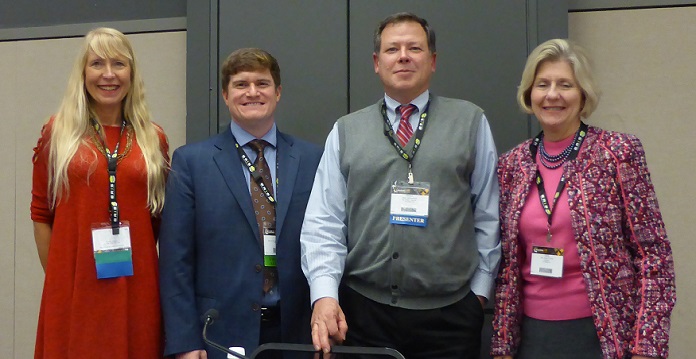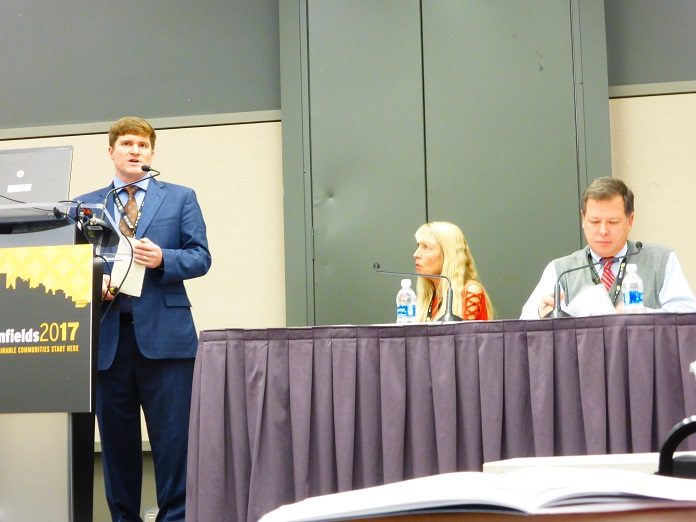By David Meade
Representatives of the Pelzer Heritage Commission, SC DHEC and Cardno attended the Environmental Protection Agency (EPA) Brownfields 2017 Sustainable Communities conference Dec. 5 in Pittsburgh, PA.
Attorney West Cox and Gilbert Garrett of PHC, Mark Berenbrok of SC DHEC and Gail Rawls Jeter of Cardno represented the PHC at the three day conference. (Pictured – West Cox (left) speaks during a presentation made by the PHC Brownfields cleanup representatives.)
During the conference they met other people from around the country involved in Brownfields cleanup efforts.
All EPA cleanup grant winners are required to attend the conference according to Cox. The PHC representatives also submitted a request to give a presentation on the Pelzer project at the conference, which they did.
Cox said while at the conference they were able to meet with leaders and represeentatives of other towns and organizations that have rehabilitated brownfields sites. He said they learned new ideas and saw how other towns and communities have handled their cleanup.
“We were able to learn from others who have similar situations in their towns,” Cox said.
The PHC group did get a good bit of attention due to their presentation on the Pelzer Mill Property cleanup.
The presentation, entitled The Mill Hill Kids Determined to Succeed, told the story of Pelzer and how members of the Pelzer Heritage Commission took on the task of acquiring the mill properties, the process they went through submitting Brownsfields Cleanup applications to EPA and administering the grants and cleanup.
The PHC presentation had “good attendance” according to Cox, with approximately 40 people attending. The presentation was one of a number going on at the conference.
People attending the PHC presentation were from other communities in South Carolina as well as fromother states.
“We got some good feedback. We were able to go and share the Pelzer story with these people and hear what others were doing.”
Cox said the PHC representatives talked with others from small towns and rural areas with similar situations.
He said there were two things that stood out to him from the conference.
First is, “that it takes so many individuals and groups to work on these sites and to succeessfully redevelop Brownsfield sites.”
And second, “that it takes several funds and groups, both private and public, to redevelop a Brownsfield site.”
“We spoke to a lot of people,” Cox said. The trip gave them the opportunity to compare what they were doing with others. “PHC has come a long way.”
Cox said the PHC project is rare in that a community non-profit is spearheading the cleanup effort.
“In most cases a town or city spearheads the projects. Most are done by a town or county government. In Pelzer, a community non-profit spearheaded the effort. The challenges are the same as everywhere else,” he said. “That is probably why we get so much attention when we go to these conferences.”
“It is important for PHC and other towns and counties to attend these conferences and look around at what others are doing. To look at new ideas and the way other people are handling theirs,” Cox said. What they learn will help, “as we grow and redevelop.”
Pictured Barbara Alfano with EPA, West Cox PHC, Mark Berenbrok of SC DHEC and Gail Rawls Jeter of Cardno.
Highlights of the PHC presentation included featuring history of the Pelzer Manufacturing Company, which was established in 1880. The Pelzer Mills were the first electrified mill from a distance of 2.5 miles and provided free grade school and lyceum paid for by the mill company.
The town of Pelzer was incorporated in 1952 with only four streets.
The presentation also included information about the PHC and how they became involved in a Brownsfield cleanup.
The PHC was formed in 2010 to preserve the history of the town of Pelzer and to help re-vitalize the town.
It reflected the potential for the area, with pictures of Pelzer and the Saluda River and that the property includes 23 acres along a three mile stretch of the river.
After acquiring the Pelzer Mills properties, PHC began their cleaup effort with the help Gail Jeter, Brownfields Specialist of Cardno, a professional infrastructure and environmental service company in Columbia.
Jeter assisted in applying for and administering grants through the EPA Region 4 Brownfields Program which included the following:
2010Assessment Grant for Anderson County Phase 1 ESA on Pelzer Mill disposal Areas.
2010 Assessment Grant to Town of Pelzer Phase I and II for ESAs on Pelzer Upper and Lower Mill properties.
2012 Targeted Brownfields Assessment which included assessment at Lower Mill and Disposal Area and an ABCA of the Disposal Areas.
The PHC cleanup also received technical assistance fby the Army Corps of Engineers or a visioning session .
Two Cleanup Grant Applications were made in 2015 for the Pelzer Mill disposal area, which was divided into an Eastern and Western parcel.
The PHC project has been supported with grass root donations, fundraisers, book sales and scrap metal sales and committed in-kind services
Strong project goals include improving access to greenspace and recreational opportunities.
Recreational attributes pointed out in the presentation include upper and lower dams which create inland lake conditions ideal for flat water fishing, canoeing and kayaking and easy access.
There is also a planned boardwalk and portage planned to connect the upper dam for another 6.5 miles of flat-water paddling.
The cleanup project also reduced toxiciy, illegal dumping and the number of blighted and vacant parcels in the coummunity.
SCDHEC has assisted with technical support and advice inlcuding EPA assessment grant support, targeted brownfields assessment of disposal areas, acquisition of properties through voluntary cleanup program,and assistance on how to close the disposal areas site ona a limited budget
PHC also requested and received a cost share waiver.
Grants have included BCRLF grant of $148,000 for disposal area and a BCRLF loan of $250,000 for lower mill.
Support from Anderson County has included the Neighborhood Initiative Program, with a match of $12,000 on a $48,000 grant from SC DHEC BCRLF, $50,000 for pallet removal and support for a Master Plan.
PHC requested and received support from the Governors office through Beth Phibbs and contacts with the SC Dept of Commerce and SC Parks, Recreation and Tourism.
The state agencies have assisted PHC with funding for master plan through Appalachain Regional Council ARC, which will also assist with industrial commercial recruiting and cleanup of mill sites.
PRT agreed to assist with park development upon completion of cleanup requirements on disposal areas.
PHC has received assistance with legal advice on acquisition of mill properties from attorney Leon Harmon.
PHC has been instrumental in establishing a historical district in Pelzer and recently announced a development agreement for the properties.

















